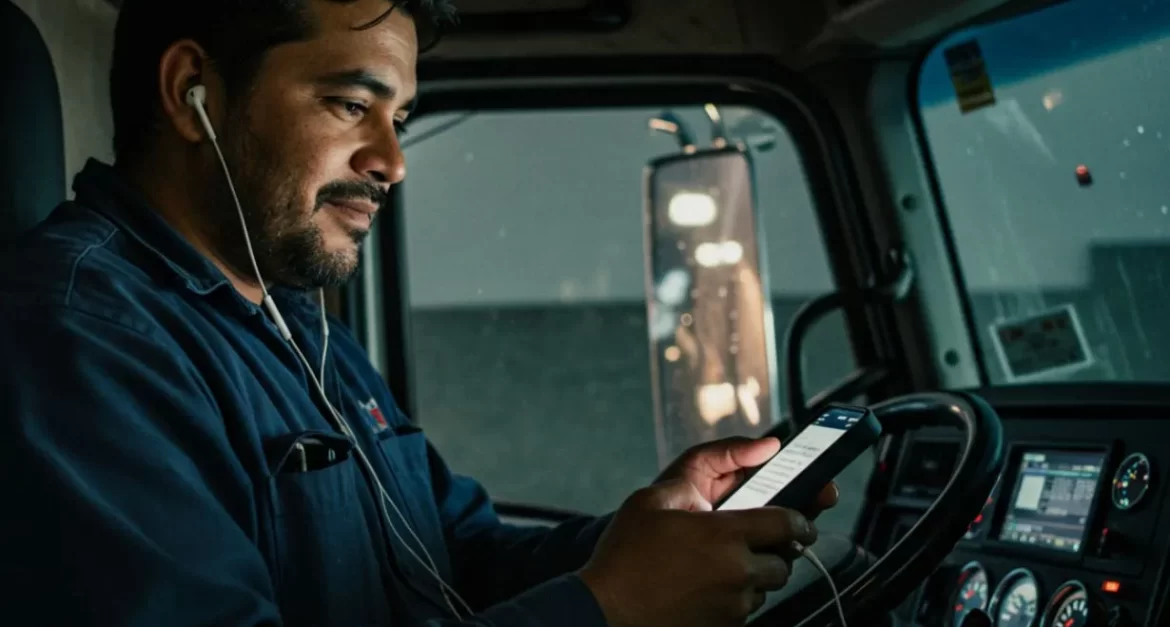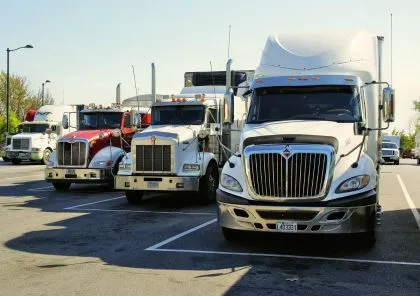
Have no time to read the entire article? How about listening to our episode? Follow us on Spotify for more valuable content:
A quick recap — why everyone’s talking about English skills again
If you drive a truck in the U.S., you’ve probably heard the chatter on the CB: “Have you seen what CVSA just did?” That buzz is real. In late April 2025 the Commercial Vehicle Safety Alliance (CVSA) voted to put English‑language ability back into the North American Standard out‑of‑service criteria. Come June 25th 2025, an inspector who feels you can’t “read and speak English well enough to communicate with officials” can park you on the shoulder until a proficient driver shows up. [CVSA] [FreightWaves]
Why now? Two big pushes converged:
- A presidential executive order. Former President Trump signed an order in late April requiring DOT to “enforce English literacy for truckers,” framing it as a highway‑safety move. [New York Post] [FreightWaves]
- Pressure from trade groups (notably OOIDA) who argued that poor communication at the scale house puts lives and freight at risk. Land Line
What exactly changed?
For ten years (2015‑2024) the English rule was technically on the books but not an out‑of‑service trigger. Violations were written, fines were paid, but drivers rolled on. CVSA’s 2025 vote flips that switch back on.
| Period | Regulatory Language | Enforcement Status | Real‑world Impact |
|---|---|---|---|
| 2005 – 2014 | 49 CFR §391.11(b)(2) – must read & speak English | Out‑of‑service if unable | ~100 000 violations/yr; ~4 000 trucks parked |
| 2015 – Jun 24 2025 | Same rule, but not listed in CVSA OOSC | Citation only | Fleets coached non‑English drivers to “get by” |
| From Jun 25 2025 | Same rule + new “English Proficiency (U.S. Only)” heading in CVSA Part I – Driver | Immediate out‑of‑service order | Truck & load sidelined until a qualified driver arrives |


Why this matters to fleets & solo drivers
- Capacity pinch. Analysts warn tens of thousands of rigs could sit idle in the first weeks if carriers don’t prep their teams. [Yahoo]
- Insurance & safety scores. An out‑of‑service hit dings your CSA profile faster than most roadside citations.
- Border runs. Canada still honors French or English, but once you cross into the States the officer will expect English answers.
- Recruiting shift. Fleets that invest in language training suddenly gain a compliance edge.
Tech to the rescue: 5 beginner‑friendly ways to learn English fast
The good news? You don’t need to be a tech wizard—or have Wi‑Fi at every truck stop—to build working English Proficiency. Here are five apps that pair well with a driver’s lifestyle:
1. Duolingo – the king of bite‑sized lessons
Open the green‑owl app during a 10‑minute fuel stop, tap through vocabulary drills, and score XP. Lessons mix reading, listening, and quick microphone checks so you practice saying phrases out loud. Completely free; lessons cache for offline use. [Android Apps on Google Play]
2. Hello English – built for absolute beginners
Choose your native language (20+ options), download lessons once, then study entirely offline from the sleeper berth. Includes a picture dictionary and slow‑speed pronunciation guides—perfect if you’re shy about mistakes. [Android] [Apps on Google Play]
3. Babbel – structured, conversation‑first courses
Each 15‑minute module teaches a dialogue (“asking for directions,” “talking to an officer”) and slips in grammar without the jargon. First lesson’s free; monthly plan is cheaper than one violation ticket. [Babbel]
4. Busuu – social learning on demand
Write or record a short answer (“Where is the weigh station?”); real native speakers correct you while you’re rolling to the next stop. Human feedback without a classroom. [Busuu]
5. Memrise – Learn with Locals video flashcards
Watch 3‑second clips of everyday people saying phrases, then mimic their rhythm. Great for picking up natural pronunciation and slang. The spaced‑repetition system schedules reviews exactly when you’re about to forget. [Memrise]
A 7‑day jump‑start plan you can do from the cab
| Day | Micro‑practice (10–15 min) | Real‑world Reinforcement |
|---|---|---|
| Mon | Duolingo Unit 1: greetings & letters | Read every highway sign aloud |
| Tue | Hello English lesson on numbers | Call dispatch and state your trailer # in English |
| Wed | Babbel: asking for directions | Ask a clerk, “Where’s the coffee station?” |
| Thu | Busuu: record a 30‑sec self‑introduction | Thank reviewers and repeat corrected sentences |
| Fri | Memrise video set on road verbs | Narrate your pre‑trip—“I check tires…” |
| Sat | Review difficult words (any app) | Watch an English trucking vlog on YouTube |
| Sun | Mock inspection Q&A with AI tutor | Reward yourself—no lessons after 6 p.m. |
Key take‑aways for carriers
- Audit your roster now. Identify drivers at risk and set up daily app‑based study goals.
- Leverage mentors. Pair new English learners with bilingual teammates for on‑the‑road practice.
- Document effort. A training log (screenshots of app streaks, company ESL sessions) can demonstrate “good‑faith compliance” if a violation is contested.
- Plan for June 25th. Build dispatcher cheat‑sheets with Spanish‑to‑English trucking phrases and keep a standby driver list in case someone is placed out‑of‑service mid‑route.
Final mile
Regulation changes come and go, but communication keeps freight moving. The CVSA rule isn’t really about accents—it’s about making sure a trooper, a scale‑house clerk, or a firefighter can warn you in plain English when something’s wrong. Thanks to 2025‑era apps, learning that “plain English” no longer means night school or expensive tutors. Whether you choose a gamified owl, a community of helpers, or video flashcards, the technology in your pocket can turn deadhead miles into language‑learning gold. Start today so that on June 25th your answer to the inspector’s “Good morning, driver—how are you?” is a confident, fluent “Doing great, officer. Here’s my logbook.”